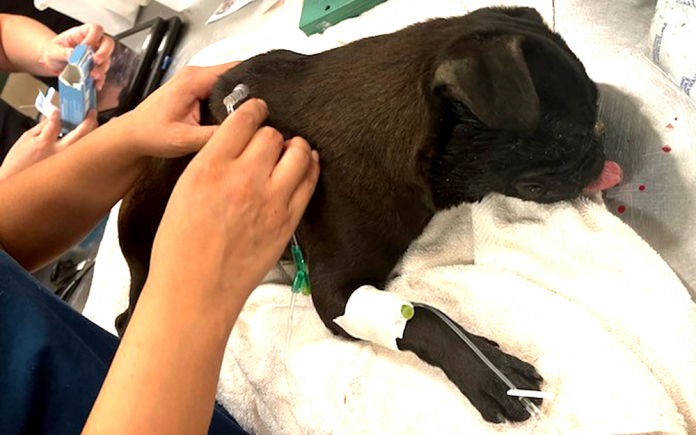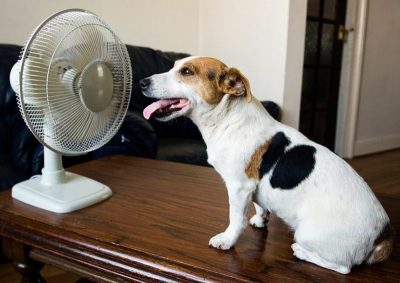
By Janet McAfee
Our soaring summer weather can bring distress and even death from heat stroke to our beloved dogs. Summer 2022 is officially here. Our Coachella Valley scorching desert is distressing to our domestic pets and can cause permanent medical problems and even death.
Sadly, during the week after the July 4th fireworks, there are more stray dog and cats roaming our community. In their frenzy, some will be killed by moving vehicles or succumb to the extreme heat. Our public shelters are overcrowded with strays.
Pictured here is the photo of a precious Pug dog fighting for his life being treated by a veterinary technician at our Riverside County shelter, the Coachella Valley Animal Campus. An animal control office found him thrashing by the side of the road near rural North Shore, and quickly transported him for medical care at the shelter. Sadly, help didn’t arrive in time to prevent the seizures and painful death this dog experienced. The scorching sand raised his body temperature to a dangerous level, and he passed away shortly after this photo was taken.
We will never know this dog’s history. He was not microchipped and had no identification tag. This incident was publicized extensively by the county’s media staff, in the hopes that it might prevent the painful suffering and deaths of other dogs whose owners keep their pets outdoors. Some of these dogs will perish without any public attention.
This dog’s legacy is to save the lives of more animals from the blazing summer weather. Even if it does not cause death, overheating can result in irreversible kidney, heart, liver and brain damage. Dogs cannot sweat the way we humans do, as their only sweat glands are in their nose and on the pads of their feet. Imagine being thirsty and drinking out of a bowl scalding hot water bowl outside. The hot weather only adds to the distress experienced by lonely “backyard only” dogs.
Dr. Andrea Walters, a veterinarian specializing in emergency and critical care, helps us understand from a medical perspective why heat stroke can be so deadly for dogs. “Heat stroke occurs when an animal’s body temperature increases so much that it cannot be regulated property and brought down. Dogs don’t sweat like people do. Instead, they pant to cool themselves down. Heat stroke causes damage to proteins and cells, which can lead to severe shock and cellular dysfunction when blood vessels near the skin dilate dangerously.”
Dr. Walters explains dogs’ need to cool through panting is why extreme heat is more dangerous to flat nosed breeds such as Pugs, Boxers, French Bull Dogs and Shih Tzu’s. While heat stroke can kill dogs of any breed, seniors and puppies are at most risk.
More precious dogs will die from heat stroke this summer, some left in cars, others left on hot patios, some kept as “outdoor only” dogs in yards. This cannot be said enough – – – BRING YOUR DOG INDOORS DURING THIS HOT WEATHER! NEVER LEAVE A DOG UNATTENDED IN A CAR!
Your dog needs potty breaks and walks outdoors. What should you do to protect him? What are the signs of heat stroke in a dog, and what life saving remedies can you take?
Take your dog on long walks in the mornings and evenings, avoiding outings when the sun is at its highest. Avoid asphalt and concrete when you walk and stick to shaded areas whenever possible. This is not the time to have him run alongside while you bicycle ride or allow him to engage in strenuous play at the dog park. Bring a bottle of water to sprinkle on him.
 Know the symptoms of heat stroke. These can include glazed eyes, heavy panting, and pulling back on the leash. Other symptoms include excessive thirst, hyperventilation, dry gums that are pale or grayish, or bright red tongue or gums. Your dog may quickly suffer weakness, staggering, confusion, vomiting, diarrhea, rectal bleeding, and ultimately collapse. Finally, if the overheating isn’t stopped, his breathing will slow, and he may have a seizure or fall into a coma.
Know the symptoms of heat stroke. These can include glazed eyes, heavy panting, and pulling back on the leash. Other symptoms include excessive thirst, hyperventilation, dry gums that are pale or grayish, or bright red tongue or gums. Your dog may quickly suffer weakness, staggering, confusion, vomiting, diarrhea, rectal bleeding, and ultimately collapse. Finally, if the overheating isn’t stopped, his breathing will slow, and he may have a seizure or fall into a coma.
Veterinarian Dr. Walters tells us, “if you suspect heat stroke, it is important to begin lowering the animal’s temperature as soon as possible, even before transporting them to a veterinarian. A hose can be used to cool the animal, focusing on the belly and paw pads. Be sure the water is cool, neither hot nor cold. If the garden hose has been sitting in the sun, the water will be very hot. It’s very important to not cool the animal too fast.” Lay the animal on a cool towel, but don’t wrap them in one as this could trap the heat. Seek vet care immediately.
What can you do to continue this Pug’s legacy? Talk to friends and neighbors who keep their dog outdoors 24 hours a day. People are resistant to change. Calmly ask them why their dog is always outside and try not to put them on the defense. Provide them with information about heat stroke. Suggest they get a baby gate and keep their dog in a kitchen or laundry room during the hot days. Give them a copy of this article. If they won’t budge on this issue, suggest they provide shade and lots of cool water with ice cubes added.
Anyone needing additional suggestions to transition their dog from outside to inside can email me. I would love to hear from you if this article changed your mind about the indoor/outdoor issue!










































